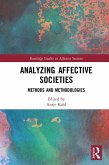Warren D. Tenhouten
A General Theory of Emotions and Social Life (eBook, PDF)
47,95 €
47,95 €
inkl. MwSt.
Sofort per Download lieferbar

24 °P sammeln
47,95 €
Als Download kaufen

47,95 €
inkl. MwSt.
Sofort per Download lieferbar

24 °P sammeln
Jetzt verschenken
Alle Infos zum eBook verschenken
47,95 €
inkl. MwSt.
Sofort per Download lieferbar
Alle Infos zum eBook verschenken

24 °P sammeln
Warren D. Tenhouten
A General Theory of Emotions and Social Life (eBook, PDF)
- Format: PDF
- Merkliste
- Auf die Merkliste
- Bewerten Bewerten
- Teilen
- Produkt teilen
- Produkterinnerung
- Produkterinnerung

Bitte loggen Sie sich zunächst in Ihr Kundenkonto ein oder registrieren Sie sich bei
bücher.de, um das eBook-Abo tolino select nutzen zu können.
Hier können Sie sich einloggen
Hier können Sie sich einloggen
Sie sind bereits eingeloggt. Klicken Sie auf 2. tolino select Abo, um fortzufahren.

Bitte loggen Sie sich zunächst in Ihr Kundenkonto ein oder registrieren Sie sich bei bücher.de, um das eBook-Abo tolino select nutzen zu können.
The scope of coverage of this key work is highly topical and comprehensive, and includes the development of emotions in childhood, symbolic elaboration of complex emotions, emotions management, violence, and cultural and gender differences.
- Geräte: PC
- mit Kopierschutz
- eBook Hilfe
- Größe: 1.88MB
Andere Kunden interessierten sich auch für
![Routledge International Handbook of Emotions and Media (eBook, PDF) Routledge International Handbook of Emotions and Media (eBook, PDF)]() Routledge International Handbook of Emotions and Media (eBook, PDF)46,95 €
Routledge International Handbook of Emotions and Media (eBook, PDF)46,95 €![A General Theory of Emotions and Social Life (eBook, ePUB) A General Theory of Emotions and Social Life (eBook, ePUB)]() Warren D. TenhoutenA General Theory of Emotions and Social Life (eBook, ePUB)47,95 €
Warren D. TenhoutenA General Theory of Emotions and Social Life (eBook, ePUB)47,95 €![Feeling Climate Change (eBook, PDF) Feeling Climate Change (eBook, PDF)]() Debra J. DavidsonFeeling Climate Change (eBook, PDF)37,95 €
Debra J. DavidsonFeeling Climate Change (eBook, PDF)37,95 €![Emotion, Embodiment and the Virtual World (eBook, PDF) Emotion, Embodiment and the Virtual World (eBook, PDF)]() Vincenzo AuriemmaEmotion, Embodiment and the Virtual World (eBook, PDF)44,95 €
Vincenzo AuriemmaEmotion, Embodiment and the Virtual World (eBook, PDF)44,95 €![Methods of Exploring Emotions (eBook, PDF) Methods of Exploring Emotions (eBook, PDF)]() Methods of Exploring Emotions (eBook, PDF)44,95 €
Methods of Exploring Emotions (eBook, PDF)44,95 €![Love as a Collective Action (eBook, PDF) Love as a Collective Action (eBook, PDF)]() Adrian ScribanoLove as a Collective Action (eBook, PDF)44,95 €
Adrian ScribanoLove as a Collective Action (eBook, PDF)44,95 €![Analyzing Affective Societies (eBook, PDF) Analyzing Affective Societies (eBook, PDF)]() Analyzing Affective Societies (eBook, PDF)44,95 €
Analyzing Affective Societies (eBook, PDF)44,95 €-
-
-
The scope of coverage of this key work is highly topical and comprehensive, and includes the development of emotions in childhood, symbolic elaboration of complex emotions, emotions management, violence, and cultural and gender differences.
Dieser Download kann aus rechtlichen Gründen nur mit Rechnungsadresse in A, B, BG, CY, CZ, D, DK, EW, E, FIN, F, GR, HR, H, IRL, I, LT, L, LR, M, NL, PL, P, R, S, SLO, SK ausgeliefert werden.
Produktdetails
- Produktdetails
- Verlag: Taylor & Francis eBooks
- Seitenzahl: 336
- Erscheinungstermin: 22. November 2006
- Englisch
- ISBN-13: 9781134229086
- Artikelnr.: 42641574
- Verlag: Taylor & Francis eBooks
- Seitenzahl: 336
- Erscheinungstermin: 22. November 2006
- Englisch
- ISBN-13: 9781134229086
- Artikelnr.: 42641574
- Herstellerkennzeichnung Die Herstellerinformationen sind derzeit nicht verfügbar.
Warren D. TenHouten, UCLA Professor of Sociology, has pioneered the interdisciplinary perspective of neurocognitive sociology. In Time and Society (2005), he presented a general theory of culture and time consciousness. Here, affect-spectrum theory classifies the primary, secondary and tertiary emotions and links each to specific, elementary social relationships.
1. Introduction 2. From Darwin to Psychoevolutionary Theories of Primary and Secondary Emotions 3. The Two Pairs of Opposite Primary Emotions: Acceptance and Disgust
Joy and Sadness
Anger and Fear
Anticipation and Surprise 4. Secondary Emotions: The Four Pairs of Opposite Primary Dyads: Love and Misery
Pride and Embarrassment
Aggressiveness and Alarm
Curiosity and Cynicism 5. Secondary Emotions
Continued: The Four Pairs of Half-Opposite Secondary Dyads: Dominance and Submissiveness
Optimism and Pessimism
Delight and Disappointment
Repugnance and Contempt 6. Secondary Emotions
Continued: The Eight Tertiary Dyads: Resourcefulness and Shock
Morbidness and Resignation
Sullenness and Guilt
Anxiety and Outrage 7. Secondary Emotions
Continued: The Four Antithetical
Quaternary Dyads: Ambivalence
Catharsis
Frozenness
Confusion 8. The Sociorelational Approach to the Emotions: Four Elementary Forms of Sociality 9. Affect-Spectrum Theory: The Emotions of Rationality and of Intimacy 10. Affect-Spectrum Theory
Continued: The Emotions Linking Informal Community and Formal Society: A Typology of Four Character Structures 11. Social Identity and Social Control: Pride and Embarrassment
Pridefulness and Shame 12. Socialization and the Emotions: From Alexithymia to Symbolic Elaboration and Creativity 13. The Development of Tertiary Emotions: Jealousy
Envy
Ambition
Confidence
and Hope 14. Emotions
Violence
and the Self 15. A Partial Empirical Test of Affect-Spectrum Theory 16. Discussion
Joy and Sadness
Anger and Fear
Anticipation and Surprise 4. Secondary Emotions: The Four Pairs of Opposite Primary Dyads: Love and Misery
Pride and Embarrassment
Aggressiveness and Alarm
Curiosity and Cynicism 5. Secondary Emotions
Continued: The Four Pairs of Half-Opposite Secondary Dyads: Dominance and Submissiveness
Optimism and Pessimism
Delight and Disappointment
Repugnance and Contempt 6. Secondary Emotions
Continued: The Eight Tertiary Dyads: Resourcefulness and Shock
Morbidness and Resignation
Sullenness and Guilt
Anxiety and Outrage 7. Secondary Emotions
Continued: The Four Antithetical
Quaternary Dyads: Ambivalence
Catharsis
Frozenness
Confusion 8. The Sociorelational Approach to the Emotions: Four Elementary Forms of Sociality 9. Affect-Spectrum Theory: The Emotions of Rationality and of Intimacy 10. Affect-Spectrum Theory
Continued: The Emotions Linking Informal Community and Formal Society: A Typology of Four Character Structures 11. Social Identity and Social Control: Pride and Embarrassment
Pridefulness and Shame 12. Socialization and the Emotions: From Alexithymia to Symbolic Elaboration and Creativity 13. The Development of Tertiary Emotions: Jealousy
Envy
Ambition
Confidence
and Hope 14. Emotions
Violence
and the Self 15. A Partial Empirical Test of Affect-Spectrum Theory 16. Discussion
1. Introduction 2. From Darwin to Psychoevolutionary Theories of Primary and Secondary Emotions 3. The Two Pairs of Opposite Primary Emotions: Acceptance and Disgust
Joy and Sadness
Anger and Fear
Anticipation and Surprise 4. Secondary Emotions: The Four Pairs of Opposite Primary Dyads: Love and Misery
Pride and Embarrassment
Aggressiveness and Alarm
Curiosity and Cynicism 5. Secondary Emotions
Continued: The Four Pairs of Half-Opposite Secondary Dyads: Dominance and Submissiveness
Optimism and Pessimism
Delight and Disappointment
Repugnance and Contempt 6. Secondary Emotions
Continued: The Eight Tertiary Dyads: Resourcefulness and Shock
Morbidness and Resignation
Sullenness and Guilt
Anxiety and Outrage 7. Secondary Emotions
Continued: The Four Antithetical
Quaternary Dyads: Ambivalence
Catharsis
Frozenness
Confusion 8. The Sociorelational Approach to the Emotions: Four Elementary Forms of Sociality 9. Affect-Spectrum Theory: The Emotions of Rationality and of Intimacy 10. Affect-Spectrum Theory
Continued: The Emotions Linking Informal Community and Formal Society: A Typology of Four Character Structures 11. Social Identity and Social Control: Pride and Embarrassment
Pridefulness and Shame 12. Socialization and the Emotions: From Alexithymia to Symbolic Elaboration and Creativity 13. The Development of Tertiary Emotions: Jealousy
Envy
Ambition
Confidence
and Hope 14. Emotions
Violence
and the Self 15. A Partial Empirical Test of Affect-Spectrum Theory 16. Discussion
Joy and Sadness
Anger and Fear
Anticipation and Surprise 4. Secondary Emotions: The Four Pairs of Opposite Primary Dyads: Love and Misery
Pride and Embarrassment
Aggressiveness and Alarm
Curiosity and Cynicism 5. Secondary Emotions
Continued: The Four Pairs of Half-Opposite Secondary Dyads: Dominance and Submissiveness
Optimism and Pessimism
Delight and Disappointment
Repugnance and Contempt 6. Secondary Emotions
Continued: The Eight Tertiary Dyads: Resourcefulness and Shock
Morbidness and Resignation
Sullenness and Guilt
Anxiety and Outrage 7. Secondary Emotions
Continued: The Four Antithetical
Quaternary Dyads: Ambivalence
Catharsis
Frozenness
Confusion 8. The Sociorelational Approach to the Emotions: Four Elementary Forms of Sociality 9. Affect-Spectrum Theory: The Emotions of Rationality and of Intimacy 10. Affect-Spectrum Theory
Continued: The Emotions Linking Informal Community and Formal Society: A Typology of Four Character Structures 11. Social Identity and Social Control: Pride and Embarrassment
Pridefulness and Shame 12. Socialization and the Emotions: From Alexithymia to Symbolic Elaboration and Creativity 13. The Development of Tertiary Emotions: Jealousy
Envy
Ambition
Confidence
and Hope 14. Emotions
Violence
and the Self 15. A Partial Empirical Test of Affect-Spectrum Theory 16. Discussion







